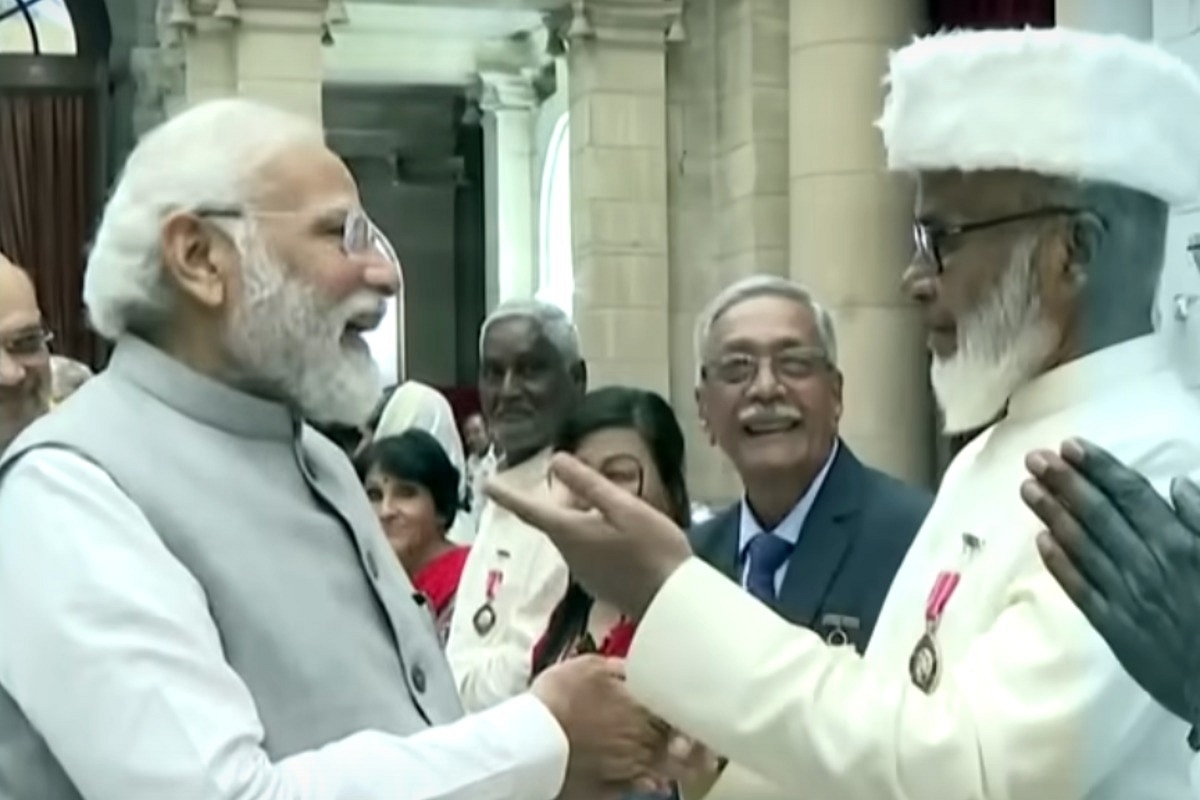Culture
When The Bidri Handicraft Went From Karnataka To BRICS

PM Modi with Shah Rasheed Ahmed Quadri (Pic Via ANI)
Earlier this year, Shah Rasheed Ahmed Quadri made headlines when he was awarded the prestigious Padma Shri by the Government of India.
Quadri, who is a Bidri craft artist, said that he expected Padma award earlier during UPA government, but didn’t get it.
Adding further, he said that he didn’t expect to get the award under the BJP government, but was thankful to the PM Modi for proving him wrong.
"You proved me wrong," Quadri told PM Modi when he came to congratulate him for the prestigious award.
Jump to August 26, Indian union minister Hardeep Singh Puri tweeted on 'X' saying that Prime Minister Narendra Modi's gifts to dignitaries in South Africa and Greece 'breathe renewed energy'.
He was referring to the Bidri vases and the 'Surahi' given to the president of Greece and South Africa, respectively.
As PM Modi handed over Bidriware as gifts to the respective heads of states, Quadri told that 'it is a matter of pride' that his handmade vases were presented to them.
What is Bidriware?
Bidriware is a handicraft that involves moulding and chiseling metals to create aesthetic items like vases, jugs, cups, bowls, hookahs, etc.
The origins of Bidriware go back nearly five to six centuries. Its artists are mostly present in north Karnataka's Bidar district and some parts of Telangana, Hyderabad being the most prominent city where the art form still exists.
According to reports, PM Modi wanted Quadri to make a special gift — a surahi — which could be presented to South Africa's president Cyril Ramaphosa. Quadri, according to the News18 report, received a phone call from officials at the Central Cottage Industries Corporation of India (CCICI).
"When I got the call, my happiness knew no bounds. I was thankful that the art form that my family and a few others in Bidar are trying to preserve is getting the much-needed recognition and impetus to keep it alive," Quadri was quoted as saying.
About Bidriware
In 2006, the dying art form received a Geographical Indication (GI) tag. For a long time, the demand for Bidriware was nearly dead in the market since the designs were considered old and 'obsolete'.
After developing new designs, things seemed to have turned around for good, for the community of artisans in Bidar and Hyderabad.
Today, there's beautiful jewellery, hardware, bowls, hookah, vases and idols made. In 2011, the Karnataka tableau during the Republic Day parade featured the art form.
How It Is Made
Bidriware consists mainly of zinc and copper, in a 16:1 ratio. Over that, an additional layer of design is engraved in silver.
There is an eight-stage process in the manufacturing of bidriware. According to this report, these eight stages begin with moulding, followed by smoothening by file, designing using chisels, engraving using chisel and hammer, inlaying the pure silver, smoothening once more, buffing and finally oxidising using soil and aluminium chloride.
The final step involve boiling the product in water, soil and aluminium chloride. The hot mud soaks the piece and receives a black colour as a result of it. The wires laid using pure gold or silver tolerate the colouration.
The soil that is used to oxidise is found in the fort at Bidar, where the soil has not seen sunlight and rain for centuries now.
Currently, there are about 200 artists in Bidar who are engaged in this craft.
Support Swarajya's 50 Ground Reports Project & Sponsor A Story
Every general election Swarajya does a 50 ground reports project.
Aimed only at serious readers and those who appreciate the nuances of political undercurrents, the project provides a sense of India's electoral landscape. As you know, these reports are produced after considerable investment of travel, time and effort on the ground.
This time too we've kicked off the project in style and have covered over 30 constituencies already. If you're someone who appreciates such work and have enjoyed our coverage please consider sponsoring a ground report for just Rs 2999 to Rs 19,999 - it goes a long way in helping us produce more quality reportage.
You can also back this project by becoming a subscriber for as little as Rs 999 - so do click on this links and choose a plan that suits you and back us.
Click below to contribute.
Latest